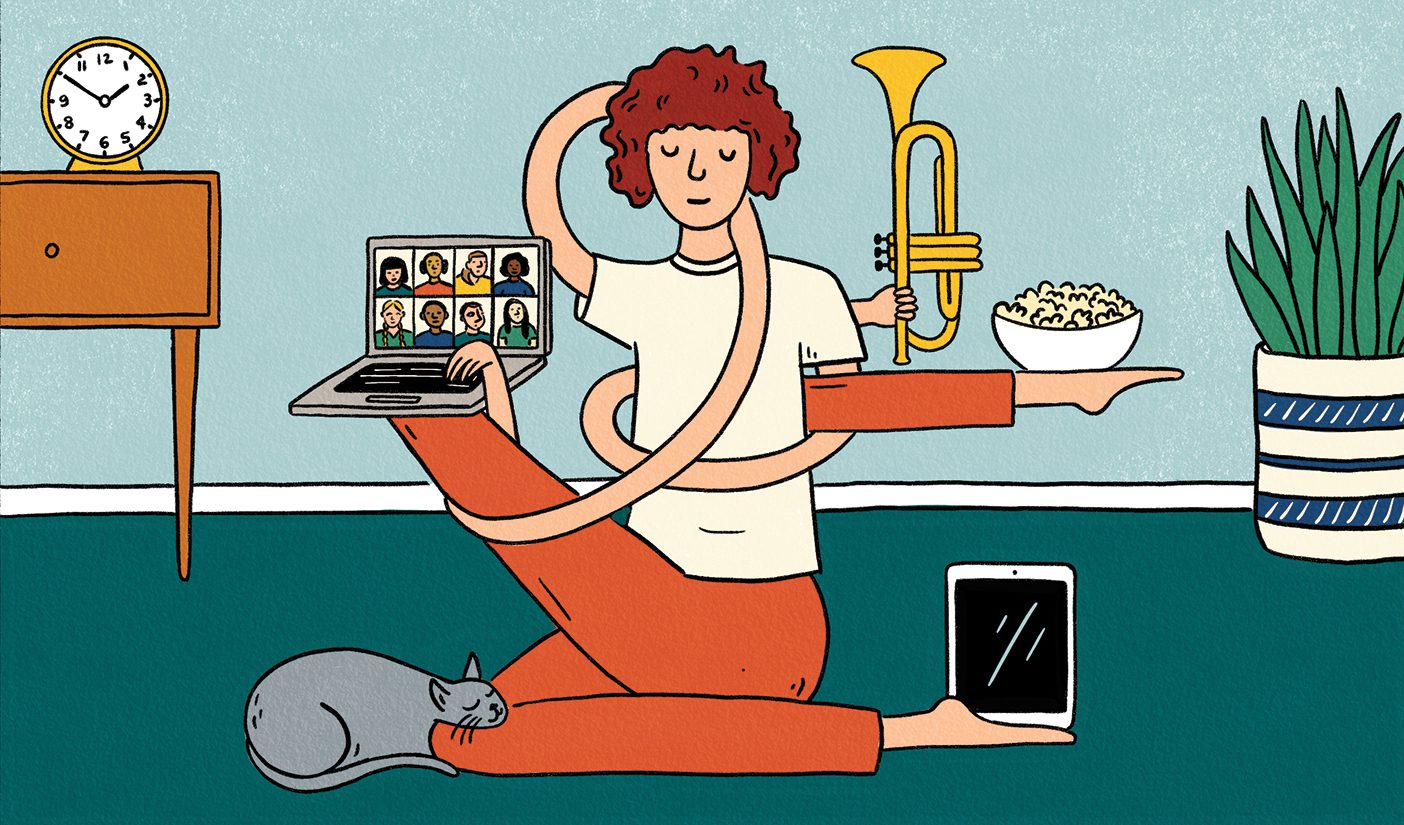How to Win @ Online Learning

Love it or loathe it, tech-supported learning is here to stay. Here’s how BYU experts are making the most of the edtech revolution with their own families.
By Melody McGrath Warnick (BA ’98) in the Winter 2021 Issue
Illustrations by Drue Wagner
Last spring’s emergency remote learning didn’t go so well for Melanye Messerly Thompson’s (BS ’07) family in Portland, Oregon.
Like millions of students worldwide, her sons were dropped into the world of full-time online learning in March, when their elementary school abruptly shuttered to fend off COVID-19. Brady, her then-fourth grader, sloughed off schoolwork to inhale YouTube videos. Ty, a kindergartner, didn’t have enough work to keep busy.
Other families, Thompson knows, fared worse. The vice president of operations at education-management company InsideTrack, she has colleagues who sit next to their children all day to keep them on task. After months of practice her sons mostly work independently now. Still, she adds, “it’s definitely not ideal.”
“Not ideal” could be the catchphrase for education over the last year. Last fall, an estimated 70 percent of American K–12 students spent at least part of their school week online, with all the glitchy Zoom calls and utter boredom that suggests. It hasn’t been easy, and you may be longing for everything to revert back to normal as soon as possible.
Yet experts believe that this era of COVID-altered learning is a watershed moment for rethinking how technology can help K–12 students learn, both now and in the future. Joseph B. South (BA ’95, MS ’00, PhD ’09), the chief learning officer for the International Society for Technology in Education and the former director of the Office of Educational Technology at the US Department of Education, describes last spring’s emergency remote learning as the educational equivalent of “grabbing our 72-hour kit and running out into the woods.” Now, he says, we have two options: We can continue to hunker down under our tarp, eat our protein bars, and wait to return to the classroom (insert sigh of relief). Or we can take an innovative Swiss Family Robinson approach to teaching and learning with technology. “You take the resources around you and start to create a world you want to be in,” says South.
How do you get the most out of this grand experiment with digital classrooms now, as well as prep your family for the increasingly wired learning that’s coming down the road? BYU experts share advice on what they do—and avoid—with their own families and imagine what the future may hold.
Help Kids Get Creative
What worries Royce M. Kimmons (BA ’05), a BYU assistant professor of instructional psychology and technology, is seeing an online class where students just sit there, watching lecture videos like zombies. “If everything is passive, that makes me wonder, what kind of learning is ultimately being achieved from this?”
“Before yelling, ‘Get off your phone!’ try to get your kids to think about their purpose, asking, ‘Why are you on your device right now?’”
If the way students interact with technology in the classroom is a kind of ladder, passive learning—like watching videos or listening to a teacher lecture on Google Meet—is the bottom rung. The next step up is interactive learning, like online quizzes and games. The top rung is creative learning: writing, creating projects, solving problems. Naturally, says Kimmons, your kids will get a little of all three, but they’re more likely to be engaged if the balance favors hands-on work, critical thinking, and brainstorming solutions to genuine challenges.
Try This: “It’s not whether you use technology; it’s how you use technology that matters,” says Richard E. West (MS ’05), an associate professor of instructional psychology and technology. You may not have control over your kids’ coursework, but you can consider the passive/interactive/creative ladder as you manage their time online. Watching Schoolhouse Rock! grammar videos on YouTube: good. Playing interactive PBSKids.com word games: better. Writing their own story or replicating a craft from YouTube: best.
It’s a struggle, West acknowledges, pointing to his own five kids, who crave social media, video games, and entire days down the YouTube rabbit hole when they’re not in school. But before yelling, “Get off your phone!” he tries to get them to think about their purpose, asking, “Why are you on your device right now?” Creative activities like reading, writing, and homework are more likely to get a parental thumbs-up. Even then, he’ll try to enforce a break every few hours for kids to go outside or make something artistic offline.

Stay More Connected
One silver lining of COVID is that some schools are reporting nearly 100 percent attendance at parent-teacher conferences. “What they’re realizing is it wasn’t that the parents didn’t care before, it’s that the parents couldn’t get to the school on Friday night between 6 and 6:15,” says Joseph South. With tools like PowerSchool or Google Classroom to monitor progress and meet with teachers, technology offers more ways to engage with your children’s school as a busy parent, equipping you to be the learning coach your kids need.
To find the balance between staying connected and getting overinvolved (South knows a second-grade teacher who has heard parents whispering answers to test questions in the background of Zoom sessions) consider your end goal. You want your kids to master material, not just pass this quiz. To get there, consider teachers as your allies. Working collaboratively, the two of you can get your child the resources she needs to succeed.
Try This: If having kids learning online all day or juggling complicated hybrid school schedules makes you feel (ironically) disconnected from them and their learning, try instituting a low-tech daily check-in. At the end of each day, South and his wife sit down with their teenage sons and ask, “What did you accomplish today? What did you discover or learn? What are your plans for tomorrow?” The Souths have been able to encourage their boys and brainstorm solutions—like figuring out a new schedule when homework started slipping through the cracks.
Customize Learning

Classrooms can feel a little one-size-fits-all as teachers try to manage the needs of 20 to 30 students at a time. But edtech tools often bake adaptive learning right into the programs, with just-in-time feedback, individualized learning modules, and lessons or games that speed up or slow down depending on students’ performance. Melanye Thompson’s son Brady, for instance, loves DreamBox Learning, an online math program, because he goes at his own pace; the games present bigger challenges only when he’s ready for them.
Some digital courses offer more tailored attention. At Mountain Heights Academy, a Utah all-online charter school, teachers use technology to track students’ engagement and progress, and they reach out quickly to nip problems in the bud. Plus, students are better able to govern their own learning, says DeLaina Cales Tonks (BA ’93, PhD ’19), Mountain Heights principal. Her own daughter’s math grades improved when she transferred to Mountain Heights in eighth grade because she could rewatch asynchronous tutorials (find similar videos at KhanAcademy.org). “She went from really struggling in math to getting what she needed because she had a space in which she could take the time to be able to learn it.”
Try This: Look for digital resources to help with classroom problems. For Rick West’s teenage daughter, it was easy to sit unnoticed in the back of her high school Spanish class. “She kept her mouth shut, never raised her hand, never said anything, and never practiced her Spanish,” says West. But then the family moved abroad for a year and she switched to an online Spanish class offered through BYU Independent Study. Because the course required a weekly one-on-one conversation with a teaching assistant, she practiced speaking Spanish more than ever before—and was able to skip a full course when she returned. (You can arrange your own foreign-language chats at websites like Preply.com.)
For Min Hu, a BYU PhD student in instructional psychology and design, the problem that technology solved was enforcing her daughters’ piano practice sessions. She downloaded the Chinese app VIP Peilian, which matches music students with online teachers who supervise their hour-long practice every day. No more arguments, and it lifts a burden from Hu.
Discover What Motivates Your Kids
In 2012 many of Jared R. Chapman’s (BS ’00, MBA ’05, PhD ’09) students were addicted to phone games such as Angry Birds and Candy Crush. Was it possible to get them addicted to his homework assignments too? Though not a big gamer himself, Chapman, an adjunct professor of psychology at BYU and an associate professor of organizational leadership at Utah Valley University, started studying game design. Turns out, the best games tap into the intrinsic psychological needs identified by self-determination theory: the need for competence (to be successful), the need for autonomy (to choose between several courses of action and make meaningful decisions), and the need for social relatedness (to feel a sense of belonging to a community).

Chapman started beefing up his Canvas online learning management system with game-like elements. To satisfy students’ need for competence, he added colorful progress meters. To add more autonomy, he structured his courses so students had choices about which assignments to do and when. For a sense of belonging, he built in avatars and leaderboards.
The result? Course withdrawals dropped by 65 percent, and failures by 50 percent. “It’s not because the students are suddenly smarter,” says Chapman. “It’s because we’re adding an overlay to the learning experience that makes students want to stay engaged.”
Try This: Use high- or low-tech ways to motivate your kids with self-determination theory. For instance, since kids respond to feeling successful, you could have them use a gamified task manager like Habitica or a goal-tracking app like Strides or Streaks to get a visual sense of completion when they finish their homework. Because the need for autonomy includes believing that what you’re doing is meaningful, Chapman recommends “helping your kids feel connected to what they’re learning.” He suggests showing kids real-world applications of a subject—for instance, by chatting with someone who uses chemistry at work. To satisfy their need for social relatedness, help them spend time with other class members, online or off. For example, Chapman’s teenage son formed an AP geography study group that meets online every few days.
Find Social Balance
COVID-era online learning is more isolating than a day spent in a physical school, so it makes sense to worry about your kids’ social lives. The surprise is how many students thrive socially in the online setting, particularly introverts, those with disabilities or social anxiety, and those on the autism spectrum. They often do better with more time to compose their thoughts. Plus, an online setting can provide respite for kids who struggle socially in traditional school.
“Students want to have social interactions, even the extreme introverts.” —Royce Kimmons
Try This: Know your children’s personalities and whether they’re likely to be meeting their social needs in an online or hybrid learning environment. Then augment with in-person interactions where possible to meet their social needs. “We found in our research that students want to have social interactions, even the extreme introverts,” says Kimmons. “But they need the ability to step away from it a little bit and to structure their own participation. So that means, yes, I can choose to go to this robotics club. And that’s very different from having to sit next to the mean kid at school every day who makes fun of me for how I talk.”
Enjoy the Flexibility
At Mountain Heights Academy, the students include teenage actors and athletes who fit the school’s asynchronous classes around demanding practice schedules. But they’re not the only ones who appreciate the flexibility. It’s one of the reasons Royce Kimmons and his wife chose to enroll their daughters at Mountain Heights. “By having a more flexible school schedule with them, it allows us to have a better home life together,” he says. “We can do things on weekdays when other people are in school.” If his daughter wants to spend a whole day tackling English then another day tackling math, without stressful transitions between subjects, she can. As principal DeLaina Tonks explains, “They can get on, they can do their schoolwork, and they can arrange their schedule in the way that works best for them.”

Try This: Consider a learning schedule to fit your student. By managing her online classes, Kimmons’s 14-year-old daughter has developed stellar time-management, from planning her day to knowing her deadlines to taking breaks when she needs to—something students don’t tend to learn until college.
But not all teenagers have the executive control to structure their online study time well (and avoid the temptations of Fortnite and TikTok). So plan to step in from time to time with what Chapman calls “choice architecture,” providing some structure that nudges your kids toward productivity. That could be keeping the phone locked in your bedroom until after you hear French horn practice or setting up midday snack breaks. Or it may just mean working alongside them occasionally. When one of his sons was struggling with the fruits of procrastination, Jared Chapman set his alarm for 5 a.m. and worked side by side with him for three hours before school. “I just offered a little scaffolding and some modeling with my own behavior,” he says.
Keep Your Kids Safe Online
These days kids are obviously spending more time on devices—but is your child actually doing algebra homework? Does she really need that phone right now?

“Don’t just drop your kid into the World Wide Web and assume that all will be well,” warns DeLaina Tonks. More time online means more chances to get into trouble. Mountain Heights Academy uses tech tools like GoGuardian to keep students from accessing pornography and time-wasting games on school-provided Chromebooks. For families, she recommends programs like Disney Circle or Bark to filter dangerous sites and limit online time. “It’s like having bumpers up on the bowling lane when you’re first learning to bowl,” Tonks says.
When kids at Mountain Heights Academy search for an inappropriate term online, administrators get an immediate alert. But Tonks is surprised by how often parents are caught off guard by the news or how often they simply refuse to believe that their child would ever think of doing something like that.
Try This: Yes, your kids are going to need technology to do schoolwork, but that doesn’t mean they should have unlimited access. Set a “tech bedtime” at least an hour before your kids go to sleep, and plug in computers, tablets, and phones in a place where kids can’t access them till morning. Enforce regular tech breaks during the day. And if your school offers a web-monitoring service like Securly, make a point of checking in regularly to see what your kid has been up to online.
Be aware that technology is addictive, and even good kids will get curious and try their luck. It’s up to you as parents, working with your child’s school, to provide some guardrails.
What’s Next?
Even though most students won’t attend online school forever (fingers crossed), BYU experts predict the classroom experience will likely become increasingly wired over the next 5 to 10 years. Textbooks will begin to be replaced with low-cost interactive content and feature personalized study plans that update in real time. Augmented and virtual-reality experiences will bring geography and history to life. Smart classrooms will start to include high-tech gadgets like smart tables, voice-activation software, or eye-tracking devices that monitor whether a student is engaged in a lesson. Holograms will make students feel like they’re in “the room where it happened” at the signing of the Constitution. Broadband and digital literacy initiatives will provide access to reliable internet and laptops for everyone, including the minority and low-income families who most struggle to access them.
Amid all this technology that feels straight out of Ready Player One, edtech can also be used to humanize education, says David A. Wiley (PhD ’00), the chief academic officer for Lumen Learning. BYU, he points out, provides faculty with a digital tool that builds flashcards from student ID pictures so they can learn their students’ names quickly. “It’s hugely impactful to stand at the classroom door while 100 students enter and greet each of them by name,” says Wiley, a former BYU faculty member who envisions teachers also having systems that track their interactions with students. “Imagine if before class the system reminded me about the email I got from you last week about your mom having COVID. Now when you walk through the door, not only can I greet you by name, I can ask about your mom’s health.”
As hard as online learning has been for Melanye Thompson’s family, even she can see some benefits from the transition to more tech-enabled education. “I feel like we’re moving in a positive direction in terms of just thinking about different ways that people can learn,” she says. “Not all students learn the same way or need the exact same approach. If we do it right, this can help us create more setups and systems where different types of learners can be successful.”
Melody Warnick is a freelance journalist who lives in Blacksburg, Virginia.
Feedback: Send comments on this article to magazine@byu.edu.




